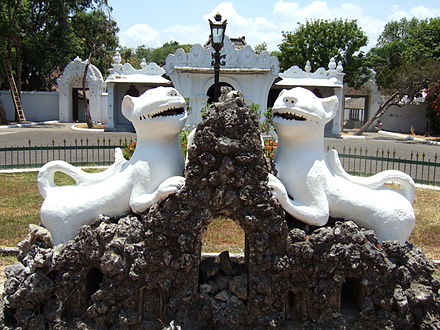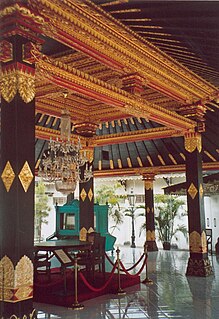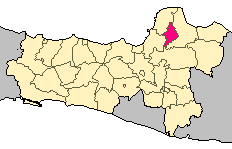


The Kraton Kasepuhan is the oldest kraton (sultan's palace) in the Indonesian city of Cirebon. It is the residence of the Sultan of Kasepuhan and the royal palace of Sultanate of Cirebon.



The Kraton Kasepuhan is the oldest kraton (sultan's palace) in the Indonesian city of Cirebon. It is the residence of the Sultan of Kasepuhan and the royal palace of Sultanate of Cirebon.
It was built in 1447 and its architecture and interior are a blend of Sundanese, Javanese, Islamic, Chinese and Dutch styles.
While the sultan still lives in the palace, several main sections are open to the public. Inside is a pavilion with white-washed walls dotted with blue-and-white Delft tiles, a marble floor and ceiling hung with French chandeliers. The legacy of Majapahit is preserved in its small pendopo on soft carved brick bases. The carvings on the pendopo columns are 1940s copy of the ancient originals. An innovation is the use of brackets branching out from the columns. [1] The main building features unusually tall pyramidal column bases. The ornament on the double braces of this building's pendopo tumpang sari ceiling are picked out by gilt. Another unusual feature in the eclectic complex is plaster and masonry columns feature a decoration that resembles reeding. Like other old sites around Cirebon, ceramics in walls are common here, although their use in the Kraton is more restrained. [2]
The palace also has a somewhat neglected small museum with a restricted display of wayang , kris , cannon, furniture, Portuguese armour, and ancient royal clothes. In a separate nearby building the very elaborate Kereta Singabarong, a 17th-century gilded coach, may be seen along with a modern duplicate carriage used on official occasions.

Cirebon is a port city on the north coast of the Indonesian island of Java. It is located in the province of West Java near the provincial border with Central Java, approximately 297 km (185 mi) east of Jakarta, at 6°43′S108°34′E. The administrative area of Cirebon city proper and its dense metropolitan sprawl into the surrounding regency; the official metropolitan area encompasses this regency as well as the city, and covers an area of 1,021.88 km2 (394.55 sq mi), with a 2010 Census population of 2,366,340.

Kraton or Keraton is a type of royal palace in Indonesia. Its name is derived from the Javanese ka-ratu-an, meaning residence of the ratu, the traditional honorific title for a king or queen. In Java, the palace of a prince is called pura or dalem, while the general word for palace is istana, identical to Indonesian and Malay.

Kudus is a regency in Central Java province in Indonesia. Its capital is Kudus. It is located east of Semarang, capital of Central Java.

Masjid Agung Demak is one of the oldest mosques in Indonesia, located in the center town of Demak, Central Java, Indonesia. The mosque is believed to be built by the Wali Songo with the most prominent figure Sunan Kalijaga, during the first Demak Sultanate ruler, Raden Patah during the 15th century.

Joglo is a type of traditional vernacular house of the Javanese people. The word joglo refers to the shape of the roof. In the highly hierarchical Javanese culture, the type of the roof of a house reflects the social and economic status of the owners of the house; joglo houses is traditionally associated with Javanese aristocrats.
Sunan Gunungjati was one of the Wali Songo, or nine saints of Islam revered in Indonesia. He founded the Sultanate of Banten, as well as the Sultanate of Cirebon on the north coast of Java.

The architecture of Indonesia reflects the diversity of cultural, historical and geographic influences that have shaped Indonesia as a whole. Invaders, colonizers, missionaries, merchants and traders brought cultural changes that had a profound effect on building styles and techniques.

A pendhapa or pandhapa is a fundamental element of Javanese architecture; a large pavilion-like structure built on columns. Either square or rectangular in plan, it is open on all sides and provides shelter from the sun and rain, but allows breeze and indirect light. The word pendhapa is cognate to the Sanskrit word mandapa ("hall").

The Sultanate of Cirebon was an Islamic sultanate in West Java founded in the 15th century. It is said to have been founded by Sunan Gunungjati, marked by his letter proclaiming Cirebon's independence from Pajajaran in 1482, although the settlement and the polity had been established earlier in 1445. Sunan Gunungjati also established the Sultanate of Banten. It was one of the earliest Islamic states established in Java, along with the Sultanate of Demak.

The Kraton Ngayogyakarta Hadiningrat is a palace complex in the city of Yogyakarta, Yogyakarta Special Region, Indonesia. It is the seat of the reigning Sultan of Yogyakarta and his family. The complex is a center of Javanese culture, and contains a museum displaying royal artifacts. It is guarded by the Yogyakarta Kraton Guards.

The Menara Kudus Mosque or Al-Aqsha Mosque is located in Kudus in the Indonesian province of Central Java. Dating from 1549, it is one of the oldest mosques in Indonesia, built at the time of Islam's spread through Java. The mosque preserves the tomb of Sunan Kudus, one of the nine Islamic saints of Java, and it is a popular pilgrimage point.
Sunan Giri Mosque is located near Gresik about 45 kilometres from the Indonesian city of Surabaya. Its pavilion shelters the tomb of Sunan Giri, one of the nine Muslim saints of Java, and like the tombs of the other wali sanga, it is a significant and highly auspicious pilgrimage point.
Kraton Kanoman is a palace in the Indonesian city of Cirebon in West Java. It was founded by Sultan Anom I in 1677. In the outer area of the palace, the siti inggil, are masonry versions of the classic Javanese pendopo form, as opposed to the more conventional timber structures. Like the Great Mosque in Demak, Chinese ceramics are embedded into the plastered walls. The squat split-gates with pyramidal peaks are a Cirebon emblem.
Kraton Sumenep is the residence of the regent (bupati) of Sumenep on the Indonesian island of Madura.

Dutch colonial architecture in Indonesia were built across the archipelago that once was known as Dutch East Indies. Most of the better and permanent colonial era structures are located in Java and Sumatra, which were economically considered more important during the Dutch imperial period. As a result, there are large number of colonial buildings concentrated in its cities. Plenty of old VOC era forts and warehouses are also scattered throughout the archipelago, particularly around Maluku Islands and Sulawesi. There are three Dutch colonial architectural styles:

Rumah adat are traditional houses built in any of the vernacular architecture styles of Indonesia. The traditional houses and settlements of the several hundreds ethnic groups of Indonesia are extremely varied and all have their own specific history.

Javanese traditional house refers to the traditional vernacular houses of Javanese people in the island of Java, Indonesia. The architecture of a Javanese house is characterized by its dominant hierarchical rule reflected in the form of its roof and its layout. Javanese traditional houses can have very similar layouts, but the shape of the roof determined the social and economic status of the house owners.

Candi bentar, or split gateway, is a classical Javanese and Balinese gateway entrance commonly found at the entrance of religious compounds, kraton palaces, or cemeteries. It is basically a candi-like structure split perfectly in two to create a passage in the center for people to walk through. The passage is usually elevated with a flight of stairs to reach it. A candi bentar is commonly found in Java, Bali, and Lombok.
The Kraton Kacirebonan is the oldest kraton in the Indonesian city of Cirebon. It has existed since 1807. This colonial building housed many historical relics such as Keris, Puppet, war equipment, Gamelan and others . Kacirebonan in the area of the District Pulasaren Pekalipan village, exactly 1 kilometers southwest of Kasepuhan Palace and approximately 500 meters south Kanoman. Kraton Kacirebonan position stretching from north to south with a land area of about 46,500 square meters.

Kuto Besak, also Benteng Kuto Besak is an 18th-century kraton in Palembang, Indonesia. Kuto Besak was the center of the Sultanate of Palembang before its abolition by the Dutch colonial government. The fort was constructed in 1780 and took seventeen years to complete. Kuto Besak was inaugurated in 1797, marked by the transfer of the royal residence from the older Kuto Lamo to Kuto Besak.